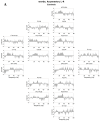Speech-Brain Frequency Entrainment of Dyslexia with and without Phonological Deficits
- PMID: 33260681
- PMCID: PMC7760068
- DOI: 10.3390/brainsci10120920
Speech-Brain Frequency Entrainment of Dyslexia with and without Phonological Deficits
Abstract
Developmental dyslexia is a cognitive disorder characterized by difficulties in linguistic processing. Our purpose is to distinguish subtypes of developmental dyslexia by the level of speech-EEG frequency entrainment (δ: 1-4; β: 12.5-22.5; γ1: 25-35; and γ2: 35-80 Hz) in word/pseudoword auditory discrimination. Depending on the type of disabilities, dyslexics can divide into two subtypes-with less pronounced phonological deficits (NoPhoDys-visual dyslexia) and with more pronounced ones (PhoDys-phonological dyslexia). For correctly recognized stimuli, the δ-entrainment is significantly worse in dyslexic children compared to controls at a level of speech prosody and syllabic analysis. Controls and NoPhoDys show a stronger δ-entrainment in the left-hemispheric auditory cortex (AC), anterior temporal lobe (ATL), frontal, and motor cortices than PhoDys. Dyslexic subgroups concerning normolexics have a deficit of δ-entrainment in the left ATL, inferior frontal gyrus (IFG), and the right AC. PhoDys has higher δ-entrainment in the posterior part of adjacent STS regions than NoPhoDys. Insufficient low-frequency β changes over the IFG, the inferior parietal lobe of PhoDys compared to NoPhoDys correspond to their worse phonological short-term memory. Left-dominant 30 Hz-entrainment for normolexics to phonemic frequencies characterizes the right AC, adjacent regions to superior temporal sulcus of dyslexics. The pronounced 40 Hz-entrainment in PhoDys than the other groups suggest a hearing "reassembly" and a poor phonological working memory. Shifting up to higher-frequency γ-entrainment in the AC of NoPhoDys can lead to verbal memory deficits. Different patterns of cortical reorganization based on the left or right hemisphere lead to differential dyslexic profiles.
Keywords: auditory cortex; developmental dyslexia; frequency oscillations; inferior frontal cortex.
Conflict of interest statement
The authors declare no conflict of interest.
Figures






References
Grants and funding
LinkOut - more resources
Full Text Sources

